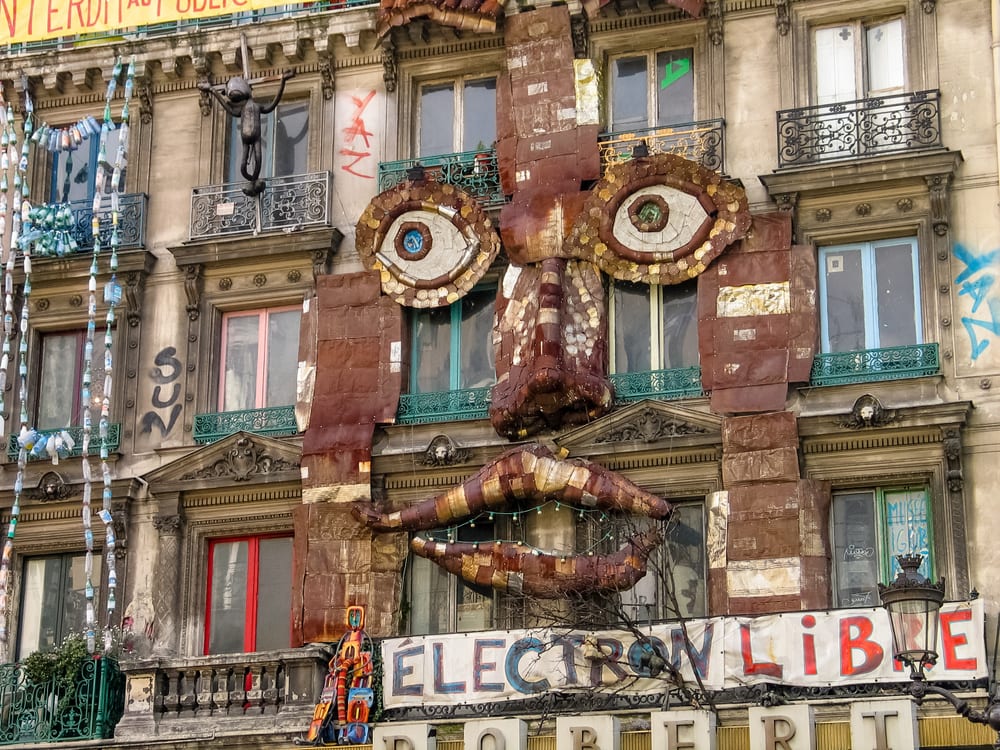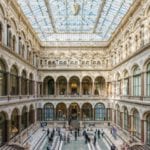 Music
Music  Music
Music  History
History 10 Less Than Jolly Events That Occurred on December 25
 Weird Stuff
Weird Stuff 10 Funny Ways That Researchers Overthink Christmas
 Politics
Politics 10 Political Scandals That Sent Crowds Into the Streets
 Weird Stuff
Weird Stuff Ten Bizarre Facts About The Doge Meme
 Our World
Our World 10 Ways Your Christmas Tree Is More Lit Than You Think
 Movies and TV
Movies and TV The 10 Coolest Stars to Set Sail on The Love Boat
 History
History 10 Things You Didn’t Know About the American National Anthem
 Technology
Technology Top 10 Everyday Tech Buzzwords That Hide a Darker Past
 Humans
Humans 10 Everyday Human Behaviors That Are Actually Survival Instincts
 Music
Music 10 Surprising Origin Stories of Your Favorite Holiday Songs
 History
History 10 Less Than Jolly Events That Occurred on December 25
 Weird Stuff
Weird Stuff 10 Funny Ways That Researchers Overthink Christmas
Who's Behind Listverse?

Jamie Frater
Head Editor
Jamie founded Listverse due to an insatiable desire to share fascinating, obscure, and bizarre facts. He has been a guest speaker on numerous national radio and television stations and is a five time published author.
More About Us Politics
Politics 10 Political Scandals That Sent Crowds Into the Streets
 Weird Stuff
Weird Stuff Ten Bizarre Facts About The Doge Meme
 Our World
Our World 10 Ways Your Christmas Tree Is More Lit Than You Think
 Movies and TV
Movies and TV The 10 Coolest Stars to Set Sail on The Love Boat
 History
History 10 Things You Didn’t Know About the American National Anthem
 Technology
Technology Top 10 Everyday Tech Buzzwords That Hide a Darker Past
 Humans
Humans 10 Everyday Human Behaviors That Are Actually Survival Instincts
Top 10 Jaw-Dropping Hidden Spaces In Paris
Ah, gay Paris! Along with London and New York, France’s capital city is amongst the most iconic and often visited city in the world. From the utterly stunning architecture and art around every corner, the world-leading gastronomic scene and the incredibly rich and the diverse history, Paris is a must for anyone interested in travel.
Despite this, tourists tend to flock to all the same ole’ spots to get a ‘feel’ for the city – the Eiffel Tower, Arc du Triomphe, shopping on the Champs Elysée and Notre Damme. Trips out to Versailles and Disneyland often punctuate a trip to Paris, along with the occasional croissant and glass of red wine. But there is so much more to this incredible city.
Some of the entries in this list are relatively well-known, some are more obscure, but there is a key difference to the “10 Jaw-Dropping Hidden Spaces In London” list is that you can readily, easily visit all the sites in Paris. You just may not have heard about them all. Until now.
10 Incredible Real Places Straight Out Of A Dream
10 Sainte-Chappelle

There are plenty of places which often get labelled as far too glibly as ‘must-sees’ by waggish travel writers—the incredibly impressive stained-glass windows of Sainte-Chappelle are well deserved of this label, however. They are incredible.
Despite being one of the best examples of gothic architecture anywhere in the world, this amazing space is often overlooked in favour of one of Paris’ many other architectural wonders—everyone goes to the Eiffel Tower, Notre Dame and the Palace of Versailles, rarely do you hear of vast numbers of tourists clamouring to get to Sainte-Chappelle. There should be a clamour because this place is as inspiring, as beautiful as any place in France’s capital city.
Nearest Metro: Cité
9 59 Rivoli

There are very few cities that can boast a semi-derelict building as a cultural landmark.
In 1999, the building at 59 Rue de Rivoli had stood in a state of abandonment, having been abandoned 15 years prior. It was then that three artists named Kalex, Gaspard and Bruno, AKA ‘KGB’ (how droll) made the place their studio. Despite attempts from the local powers that be to evict them, by 2005 the city had relented, allowing the space to be a permanent home for artists to work.
The graffiti-daubed walls and higgledy-piggledy layout feels a bit like you are entering an art hovel, as opposed to a gallery or a studio – indeed, the place is often referred to as an “art squat” – the sense or urban degradation and decay is always in the background here, top-noted by the colourful, creative artworks found around every corner, in every nook and even the occasional cranny. Still, even with all the bo-ho, down-and-dirty chic, the building itself has great bones – the artfully designed spiral staircase is beautiful, even when the twisting wall alongside it is painted thick with unblinking eyes.
The fact such a vibrant living space for art to be formed and viewed harkens back to the turn of the 19th century or the early 20th century, a time when Paris was the epicentre for artistic innovation. You may not like some of the art featured at 59 Rivoli, but the fact that art lives and continues to thrive in an increasingly stultifying age that produces very few notable movements or trends is surely something to be celebrated.
Nearest Metro: Châtelet
8 Beefbar

An aesthetically pleasing restaurant in Paris? You must be kidding!
When you get to ‘The City of Light’ you will soon notice that there are so many great places to eat. Little cafés that’ll provide you a great breakfast, hole-in-the-wall restaurants that are famous for one particular dish since 1780 and haute cuisine places with enough stars and rosettes that they don’t need wallpaper. Beefbar, within view of the iconic lump of metal that is the Eiffel Tower, fits into most of these categories. Haute cuisine? Check. Singular and iconic? Yup. Specializes in a particular dish/ingredient? You’d better bring a rag – you’re going to be meat-sweating.
This place is a real gem amongst the sea of diamonds found in the world’s gastronomic capital—less visited than ‘Le Fouquet’s’, ‘Café de Flore’ or ‘Tour D’Argent’, but sits comfortably amongst them. Set in what was formerly ‘The Lamgham Hotel’ in the central 8th arrondissment, the interior of the restaurant has been tastefully restored to its original joyous art nouveau glory.
After having been abandoned during WWII, only to be uncovered, designated an historical monument and then left once more in the 80s, the building was taken on and re-developed by restauranteurs Ricardo Giraudi, Emil Humbert and Christophe Poyet. Running counter to their usual philosophy of “refined simplicity” found in the more minimalist settings of their other ventures, Beefbar in Paris demands celebration – it is a gastronomic temple to beauty.
Plus, they do a pretty mean steak. With frites, of course.
Nearest Metro: Alma-Marceau
7 La Bibliothèque Interuniversitaire Sorbonne

The Annenberg Dining Hall at Harvard University in the US is beautiful. The Ashmolean Museum in Oxford shows off the contribution the University has made to architectural excellence. The post-brutalist concrete cathedral dedicated to music that is the Toho Gauken School of Music in Japan is as bold as they come. They all pale in comparison to the interior of the Sorbonne’s splendid library.
You may feel that French porcelain can be a little overwrought and gaudy, but after visiting this library you’ll realise that it’s all a matter of scale – if those fancy objets d’art were re-shaped into a reading room, then it would be as gorgeous as the Sainte-Jacques reading room in Paris.
Although you need to be a student or a prof to actually borrow a book (and with over 2.5 million titles lining 40 km-worth of shelf space, you’d have plenty of choice), who the hell cares? Look at the gorgeous, opulent interior. Stunning ivory mouldings lead the eye to the romantic paintings that line the walls and ceilings, scenes of learning from centuries past. The gorgeous pastel blue-green walls with scrolling floral patterns couldn’t be more distracting for readers, but again, who cares?
It is truly incredible that a merger of gentile, pastille-hued prettiness and grand opulence could come together and actually make sense. Only in Paris.
Nearest Metro: Cluny-La Sorbonne
6 Promenade Plantée

Paris has turned a disused railway track into a beautiful garden walk through the city, allowing people, should they choose, to re-enact their own gallic version of ‘Stand By Me’… without jumping off a trestle to avoid a train or defend the body of a dead child with a gun stolen from an alcoholic –
*Author’s Note* I asked the concierge at my hotel if he knew any gun-owning alcoholics from whom I could borrow a 1911 before I went on my walk. He just stared at me before walking away; service staff are a good deal ruder in France.
When the city turned a disused viaduct into one of the world’s first elevated urban walkways back in 1993, locals decried the project as a waste of money. Nowadays, it is seen as a=the scenic, peaceful nirvana that it truly is, sitting above the hustle and bustle of one of the world’s foremost metropolises.
The 3-mile-long path will take you from the Bastille to Paris’ largest park, the Bois de Vincennes. From the little pools in the gardened area to the views of the city’s rooftops, you’ll get a perspective of Paris that you’d otherwise miss at street level.
Nearest Metro: Ledru-Rollin
5 Musée Bourdelle

As amazing as the far more popular Louvre and Museé d’Orsay are, you may want to check out this intimate and fascinating little museum. As with many of Paris’ smaller museums, it is housed in a townhouse. The difference here is this museum was famed sculptor Antoine Bourdelle’s actual studio.
It’s one thing to go and look at some sculptures by Alberto Giacometti, Henry Moore or (Bourdelle’s mentor) Auguste Rodin. But at this little building, found in the shadow of Paris’ second tallest skyscraper, Tour Montparnasse (go to the top for the best view of the city), you can not only see some amazing sculptures by an amazing artist, but also the tools of his trade. Take note of the multiple plaster casts the artist took for the bust of Ludwig Van Beethoven, as well as many pieces for Bourdelle’s personal collection, including works by Rodin, neoclassicist Ingres and one of the forerunners to the impressionist movement Adolphe Monticelli.
Nearest Metro: Falguière
4 Le Collège des Bernardins

Amidst the glorious neo-gothic architecture, the touches of arts nouveux and deco, the modern, shining metals and plastics and the neo-classical bridges and statues, it is easy to think that Paris began in 1700. Of course, the city is older than that. A lot older. In no place is this more evident than in the Collège des Bernardins, a 13th century building found in the city’s Latin Quarter.
Built in 1248, the building was used as a college and monastery by the Cistercian order right up until the terror of the French Revolution. Since the stunning building was renovated in 2008, it has become the home of the “Académie catholique de France”, a group of academics who seek to expand intellectual dialogue and research.
The sparingly plain stone interior nave serves to amplify the magnitude of the space, separated by swooping medieval columns, it serves to remind us that the monastic life was a strange combination of the austere and the sublime – some monks were pious and silent men, some were bawdy drunkards. There are numerous spaces available for hire, including the vast nave, ensuring that you can party like it’s 1399.
Nearest Metro: Cardinal Lemoine
3 The Grand Mosque

Another religious centre that is truly awe-inspiring yet criminally overlooked by visitors is the Grand Mosque. The stunning Moorish motifs employed in all parts of the building serve to transport visitors back to a time where the Islamic and European worlds barely touched one another, save on the Iberian frontier – beautiful geometric Zellij mosaics within and artfully crafted crenelations on the striking rectangular minaret outside yield to the glorious, lush Andalusian Garden, replete with fountains and precisely planted shrubs.
From the intricate tilework to the equally complex carvings found on the pillars of the interior court, France’s oldest metropolitan mosque is a feast for the eyes.
It also has a fascinating history – during the Nazi occupation of France, the founder of the mosque, Si Kaddour Benghabrit, managed to secure Muslim identification papers for several Sephardic Jews in the city. Given their shared North African heritage and use of Arabic, it was easy for these Jews to pass as Muslims.
Nearest Metro: Place Monge
2 Sainte-Geneviève Library

Our second library on the list is another stunner. The huge reading room, with its vaulted ceilings and exposed cast iron columns, the long walls lined with uniform bookshelves, topped with a total of 46 arched windows that bathe the impressive space with light, are just as stunning as the couture sported by the models who parade down the catwalks at the city’s fashion week.
As ‘right’ as the space looks, it wasn’t always considered thus – when it was built back in 1847, it was startlingly innovative -perhaps the first true expression of architectural beauty that made such heavy (pardon the pun) use of iron, both in the beautifully designed cast-iron arches and the innovative use of iron mesh to support the plasterwork in the vaulted ceiling. A writer for Insider.com wrote that the space was reminiscent of Hogwarts from the Harry Potter universe. But, in all honesty, this space is far more ‘magical’, given that the feats of architecture on show here are very real.
Nearest Metro: Cardinal Lemoine
1 Musée du Parfum—Frangonard

Beyond gastronomy, high fashion and the visual arts, Paris can also lay claim to being the world’s foremost centre for perfumery, rivalling Newark, New Jersey for the title of “Foremost Creator of the World’s Smells”.
Whilst the building that houses the museum is nice enough (a Napoleon III-era townhouse in the 9th arrondissement), it is the experience within the walls that delights. Exhibits are arranged in chronological order, dating from ancient times to the 20th century, charting the progress of perfumery through the ages.
If looking at 16th century pomanders and Etruscan perfume vases isn’t your thing, the museum also boasts an “olfaction room” where you can smell the changes in perfume trends from the beginning of the 20th century. There’s also a perfumer’s workshop where you can learn about the art of making things smell nice.
We often focus on sights and tastes when we visit somewhere new. The perfume museum will ensure that all your senses are delighted on your Parisian sojourn… except touch. Maybe just stroke a baguette on your way home.
Nearest Metro: Opéra
Top 10 Museums that will Scare You Silly
About The Author: CJ Phillips is a storyteller, actor and writer living in rural West Wales. He is a little obsessed with lists.








